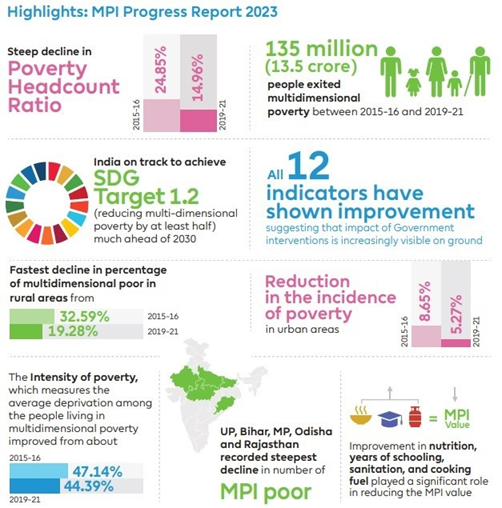MULTIDIMENSIONAL POVERTY IN INDIA
TOPIC: MULTIDIMENSIONAL POVERTY IN
INDIA
WRITTEN BY: VASHVI SINGH
LL.B GRADUATE
MARATHA VIDYA PRASARAK SAMAJ LAW COLLEGE, NASHIK
EDITED BY: VAISHNAVI PARATE
LLM 1ST YEAR
SHRI NATHMAL GOENKA LAW COLLEGE, AKOLA
ABSTRACT
This article aims to educate the
reader regarding the intensity of deprivation due to multidimensional poverty,
the reasons for it, the attempts made by India to improve, and the way forward.
The article focuses on two reports multidimensional poverty index and the
National multidimensional poverty index to make the reader understand the
various indicators of multidimensional poverty and various kinds of
deprivations faced by people in India and around the world.
KEYWORDS
POVERTY, LIVING STANDARD, HEALTH,
EDUCATION, UNDP, NITI AAYOG, MULTIDIMENSIONAL.
INTRODUCTION
The World Bank defines
multidimensional poverty as a state of disadvantage in multiple areas of life,
including education, health, living standards, availability of essential
amenities, and social integration. The global multidimensional poverty index, released
by The Oxford Poverty and Human Development Initiative (OPHI) and United
Nations Development Program (UNDP), tracks deprivation in 10 areas, including
health, education, and living standards. It aggregates statistics from 110
developing countries covering 6.1 billion people, which represents 92 per cent
of the developing world's population.
KEY
INDICATORS-
|
1)Health
|
a) Nutrition b) Child mortality |
|
2)Education |
a) Years of schooling b) School attendance |
|
3)Living standards |
a) Cooking fuel b) Sanitation c)Drinking water d)Electricity e) Housing f) Assets |
1) In 110 nations, 485 million
impoverished people suffer from extreme poverty
2) More than fifty per cent (566
million) of the world's poor are children under the age of 18.
3) Rural poverty is prevalent in all
world regions, accounting for over 84 per cent of the poor. In South Asia,
rural-urban gaps are stark, with approximately 340 million (87.5 per cent) poor
people living in rural areas compared to 49 million (12.5 per cent) in urban
areas.
4) In 110 countries, 824-991 million
of the 1.1 billion impoverished people have no access to proper sanitation,
housing, or cooking fuel.
5) Over fifty per cent of the poor
have no access to nutrition, electricity, or years of schooling.
6)Around 245 million people lack
access to nutrition.
7)Nearly 444 million people lack
access to electricity.
8) Except in Europe and Central
Asia, nearly fifty per cent of the poor live in households where no individual
has finished a minimum of six years of schooling.
REASONS
FOR MULTIDIMENSIONAL POVERTY
a) Agricultural land deterioration,
b) Climate change and environmental
issues.
c)Lack of good governance,
corruption and malpractices
d)Gender bias
e) Conflicts, wars, and genocides.
f) Lack of targeted intervention,
depending on the needs of a region
g) Unable to provide last-mile
connectivity.
INDIA’S
PERFORMANCE
In India, nearly 230 million people
face multidimensional poverty. Despite this stark figure India has seen some
remarkable progress-
a)415 million people were lifted out
of poverty from 2005-2021.
b) In all the indicators,
deprivation has witnessed a remarkable downward trend.
c)Nutritional deprivation has
declined from 44.3% to 11.85 and child mortality has declined from 4.5% to
1.5%.
d)Remarkable progress has been witnessed among the poorest states, groups, children and castes that suffer from disadvantage.
NITI
Aayog’s National Multidimensional Poverty Index, the first of its kind was released
in July 2023, it had 3 weighted dimensions-Health, education and standard of
living and 12 indicators under it-Nutrition, child and adolescent mortality,
maternal health, years of schooling, school attendance, cooking fuel,
sanitation, drinking water, electricity, housing, assets, and bank accounts.
a) Nearly 13.5 crore people moved
out of multidimensional poverty.
b) The fastest decline was seen in
the rural areas, from 32.59% to 19.28% in just six years, from 2015 to 2021.
c)The intensity of poverty has also
declined to 44% from 47.14%.
d)Uttar Pradesh witnessed the
steepest decline with nearly 3.43 crore moving out of multidimensional poverty
and Bihar witnessed the fastest decline in absolute terms.
REASONS
FOR REDUCTION IN MULTIDIMENSIONAL POVERTY IN INDIA.
1)Targeted interventions and various
schemes of government have helped reduce Multidimensional poverty.
2)Initiatives like Poshan Abhiyan,
and Swachh Bharat Mission have improved health and sanitation.
3)Pradhan Mantri Awas Yojna and
Samagra Shiksha have improved housing and education.
Way
forward
There are still nearly 230 million
people facing multidimensional poverty in India, a part of 485 million poor
people in developing countries. The way forward should be
a) Targeted intervention with a
special focus on women, children and disadvantaged castes., agriculture and
climate change.
b) Sector-specific and
state-specific intervention, as every state has a unique type of
multidimensional poverty.
c)Cooperation and coordination
between inter-departments and intra-departments.
d)Improving last-mile connectivity
through the help of panchayats, NGOs, and local government.
e) Increasing awareness about
government schemes through dedicated portals, social workers, and digital
media.
f) Fast and focused governance
through citizen-centric mediums, to provide holistic, time-bound grievance
redressal.
g) Connecting and collaborating with
international institutions to promote connectivity, condemn violence and
promote peace and harmony.
h) Entering into bilateral and
multilateral agreements with developed and developing states making progress
and studying their path and method of reducing inequality and poverty.
CONCLUSION
Multidimensional poverty aims to end
the intensity and incidence of poverty. The Global multidimensional poverty
index should be read, and measures mentioned to reduce poverty and deprivation
should be practised. The aim should be to reduce inequality in all spheres and
improve the reach of governance. The NITI Aayog report shows the remarkable
progress made since 2015, and it’s a step in the right direction, however since
nearly 230 million people in India still carry the burden of being deprived
multidimensionally at all levels, targeted and regional-specific plans should
be made, along with improving the reach of governance and government schemes.
References-
1)2023mpireportenpdf.pdf
(undp.org)
2)
India-National-Multidimensional-Poverty-Index-2023.pdf
(niti.gov.in)





Comments
Post a Comment